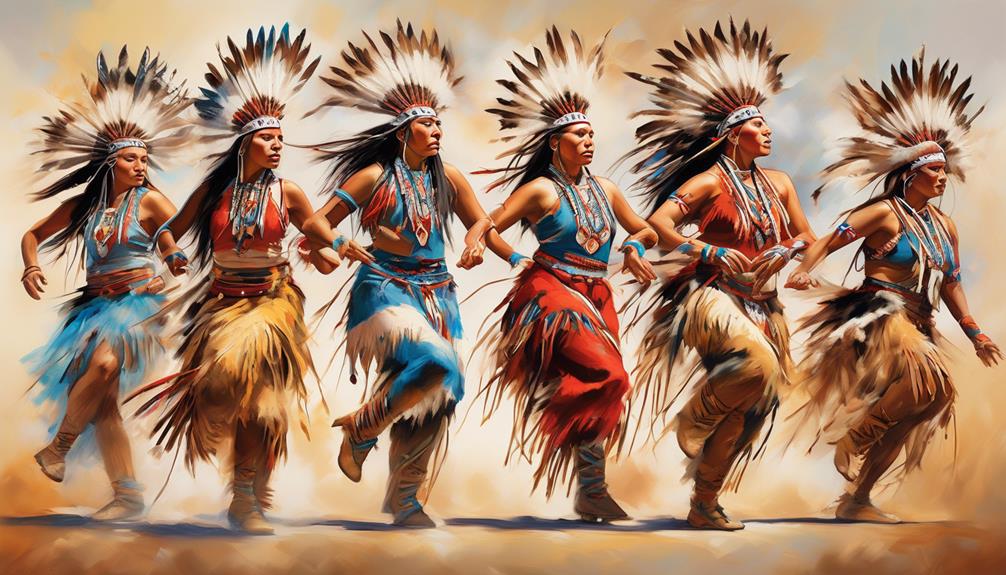When it comes to Native American dance, there is a wide range of traditions and styles that many people may not fully grasp. The intricate movements and vibrant costumes are a significant part of this cultural expression, going far beyond just aesthetics.
Whether you're a newcomer or have some experience in dance, there's always more to learn and appreciate about the cultural significance and history behind Native American dance.
So, if you're ready to uncover the beauty and complexity of this art form, let's explore the world of Native American dance together.
Key Takeaways
- Cultural etiquette and respect for traditions and elders are crucial in Native American dance.
- Traditional regalia and attire, crafted with skill and artistry, hold cultural symbolism and represent tribal heritage.
- Rhythmic footwork and movements in Native American dance carry the stories, history, and spirit of the Native American people.
- Different styles of Native American dance reflect the traditions, values, and unique footwork of different tribes.
Understanding the Cultural Significance
Understanding the cultural significance of Native American dance requires delving into the rich tapestry of traditions, values, and beliefs that have shaped and continue to influence these vibrant and meaningful expressions.
Cultural etiquette is central to Native American dance, with specific protocols governing participation and behavior. These protocols serve as a means of honoring the traditions and maintaining the integrity of the dance. Respect for the elders and the knowledge they impart is crucial, as they're the bearers of wisdom and the custodians of sacred dances.
Spiritual connections are woven into the fabric of Native American dance, with movements often symbolizing elements of nature, animals, and ancestral spirits. The dance isn't merely a physical expression but a spiritual journey, a way of connecting with the divine and the natural world. Understanding the spiritual significance of each movement and gesture is essential to appreciating the depth of meaning within Native American dance.
Through these expressions, the community honors its past, celebrates its present, and connects with the spiritual essence of its existence.
Exploring Traditional Regalia and Attire

Frequently, traditional regalia and attire worn during Native American dances embody centuries-old customs and hold profound cultural significance. The regalia craftsmanship reflects the artistry and skill of Native American artisans, often incorporating intricate beadwork, quillwork, and traditional materials such as leather, feathers, and fur. The traditional dance attire varies among different tribes, with each having distinct styles and designs that are passed down through generations.
- Cultural Symbolism
The regalia and attire worn during Native American dances are rich in cultural symbolism, representing the connection to nature, the spirits, and tribal heritage. For example, the choice of colors, animal motifs, and patterns often conveys specific meanings and stories that are deeply rooted in tribal traditions.
- Rhythmic Footwork Techniques
The design and construction of traditional regalia and attire are intricately tied to the rhythmic footwork techniques employed during Native American dances. The materials and embellishments are chosen to enhance movement and create a mesmerizing visual display, harmonizing with the dancers' movements and the beat of the drum.
This cultural perspective delves into the significance of regalia craftsmanship, the diversity of traditional dance attire, the cultural symbolism embodied in the attire, and its connection to rhythmic footwork techniques.
Mastering Rhythmic Footwork and Movements

Mastering the rhythmic footwork and movements in Native American dances demands a deep understanding of the cultural significance and a dedicated commitment to embodying the traditions passed down through generations. Dance techniques and cultural traditions are intricately woven into the fabric of Native American dance, making it essential to approach footwork mastery with the utmost respect and diligence. Authentic movements are not just steps; they carry the stories, history, and spirit of the Native American people.
| Dance Technique | Cultural Significance | Footwork Mastery |
|---|---|---|
| Balanced Stance | Connection to the Earth | Precision and Grace |
| Flowing Transitions | Symbolism of Nature | Fluidity and Control |
| Expressive Gestures | Storytelling Tradition | Emotion and Intention |
| Grounded Movements | Ancestral Respect | Strength and Agility |
To master the rhythmic footwork and movements in Native American dances, one must immerse themselves in the cultural significance of each step, transition, and gesture. Every movement tells a story and embodies the rich history and traditions of the Native American people. By embracing the dance techniques and cultural traditions with reverence, individuals seeking mastery can honor and preserve the authenticity of Native American dance.
Embracing Different Styles of Native American Dance

Embracing the diverse styles of Native American dance is an enriching journey that immerses us in the vibrant tapestry of indigenous cultural expressions. As we delve into the realm of Native American dance, we encounter a rich array of styles that reflect the diversity of tribal traditions and histories. In this exploration, we come to appreciate the profound significance of cultural appreciation and the nuances of various dance techniques.
- Cultural Appreciation
Understanding the historical and cultural context of each dance style fosters a deep appreciation for the traditions and values of different Native American tribes. Engaging with the stories and symbolism embedded in the movements allows for a meaningful connection to the spiritual and ceremonial aspects of the dances.
- Dance Techniques
Mastering the unique footwork, body movements, and gestures specific to each dance style requires dedication and attentiveness to detail. Exploring the distinct rhythms, tempos, and musical accompaniment associated with different dance styles enhances our understanding of the interconnectedness between music and movement in Native American traditions.
Honoring the History and Heritage of Native American Dance
As we explore the diverse styles of Native American dance and the profound significance of cultural appreciation, it becomes imperative to honor the history and heritage that underpin these captivating expressions.
Traditional rituals hold a sacred place in the hearts of Native American communities, and the dance serves as a medium to convey their stories, beliefs, and emotions. It's crucial to recognize the spiritual connection and communal celebration embedded in Native American dance, as it reflects the deep-rooted traditions passed down through generations.
Furthermore, acknowledging the modern adaptations of these dances is essential in understanding how they've evolved while retaining their cultural essence.
The history and heritage of Native American dance are intertwined with the very fabric of their identity, making it essential to approach these art forms with respect and understanding. Through extensive field research, it's evident that these dances aren't merely performances but rather a manifestation of the collective experiences and values of indigenous peoples.
Mastery in honoring the history and heritage of Native American dance lies in delving beyond the movements and costumes, and embracing the profound significance of these cultural expressions.
Frequently Asked Questions
What Are Some Common Misconceptions About Native American Dance and How Can They Be Addressed?
Common misconceptions about Native American dance include stereotypical portrayals as primitive or monolithic. These can be addressed through cultural understanding and respectful engagement with Native communities.
Authentic representation involves recognizing the diversity and complexity of Native dance traditions. Misconceptions can be dispelled through education and promoting accurate portrayals.
Are There Specific Rituals or Ceremonies That Are Often Associated With Native American Dance?
Ceremonial significance is a vital aspect of Native American dance, with specific rituals and ceremonies often associated with it.
Traditional attire holds deep cultural and spiritual meaning, embodying the essence of the dance.
Respecting these traditions is crucial to avoid cultural appropriation.
Understanding the ceremonial significance and the cultural context of the attire is essential in honoring and preserving the authenticity of Native American dance.
How Does One Respectfully Participate in or Observe a Traditional Native American Dance?
Respectful participation in traditional Native American dance requires cultural sensitivity. Observing proper etiquette and understanding the significance of dance attire and symbolism is crucial.
It's essential to approach participation with an open mind and willingness to learn from the community. Engaging with humility and respect for the cultural traditions is key.
What Are Some Ways to Support and Preserve the Traditions of Native American Dance Within the Community?
Community involvement is essential for supporting and preserving Native American dance traditions. By actively participating in cultural events and ceremonies, we can demonstrate our respect and appreciation for these traditions.
Additionally, cultural education programs can be organized to teach the history and significance of Native American dance within the community. These efforts help to ensure that these traditions continue to thrive and are passed down to future generations.
Are There Specific Etiquette or Protocols to Follow When Attending a Native American Dance Performance or Event?
When attending a Native American dance performance or event, it's crucial to observe proper etiquette and demonstrate cultural understanding.
This includes respecting sacred items, refraining from photography without permission, and refraining from interrupting the dancers.
Understanding the significance of the event and showing appreciation for the traditions being shared is essential.
Conclusion
In conclusion, Native American dance is a vibrant and rich tradition that holds deep cultural significance.
By exploring the traditional regalia, mastering rhythmic footwork, and embracing different styles, we can honor the history and heritage of Native American dance.
The rhythmic movements and vibrant colors create a powerful and captivating display that reflects the resilience and spirit of Indigenous peoples.
It's a celebration of identity, history, and tradition that continues to thrive in modern times.









